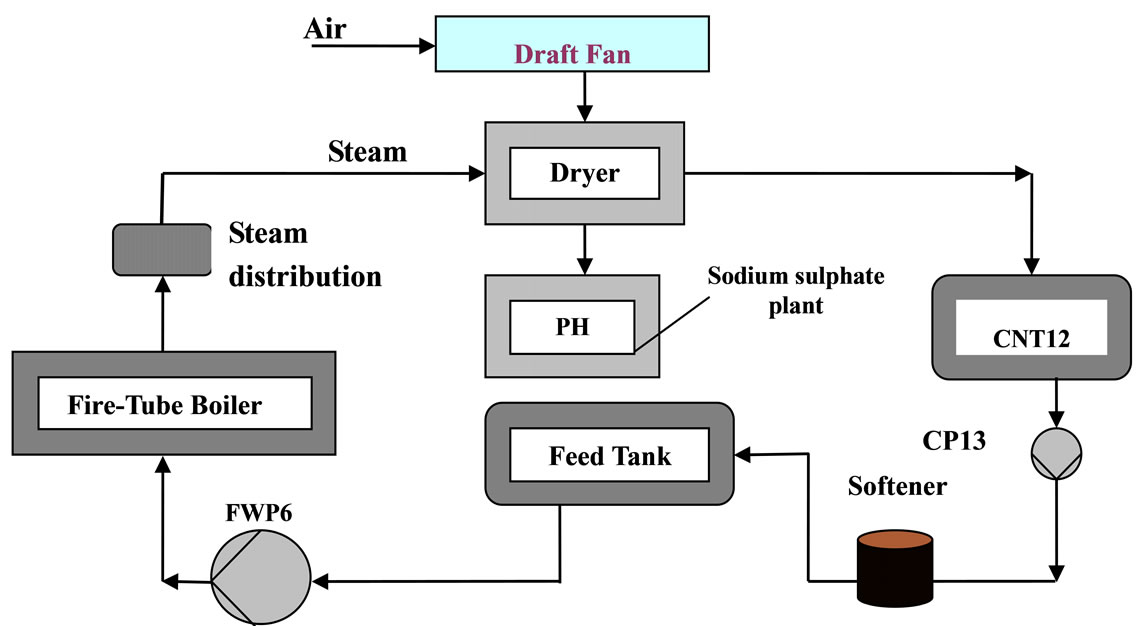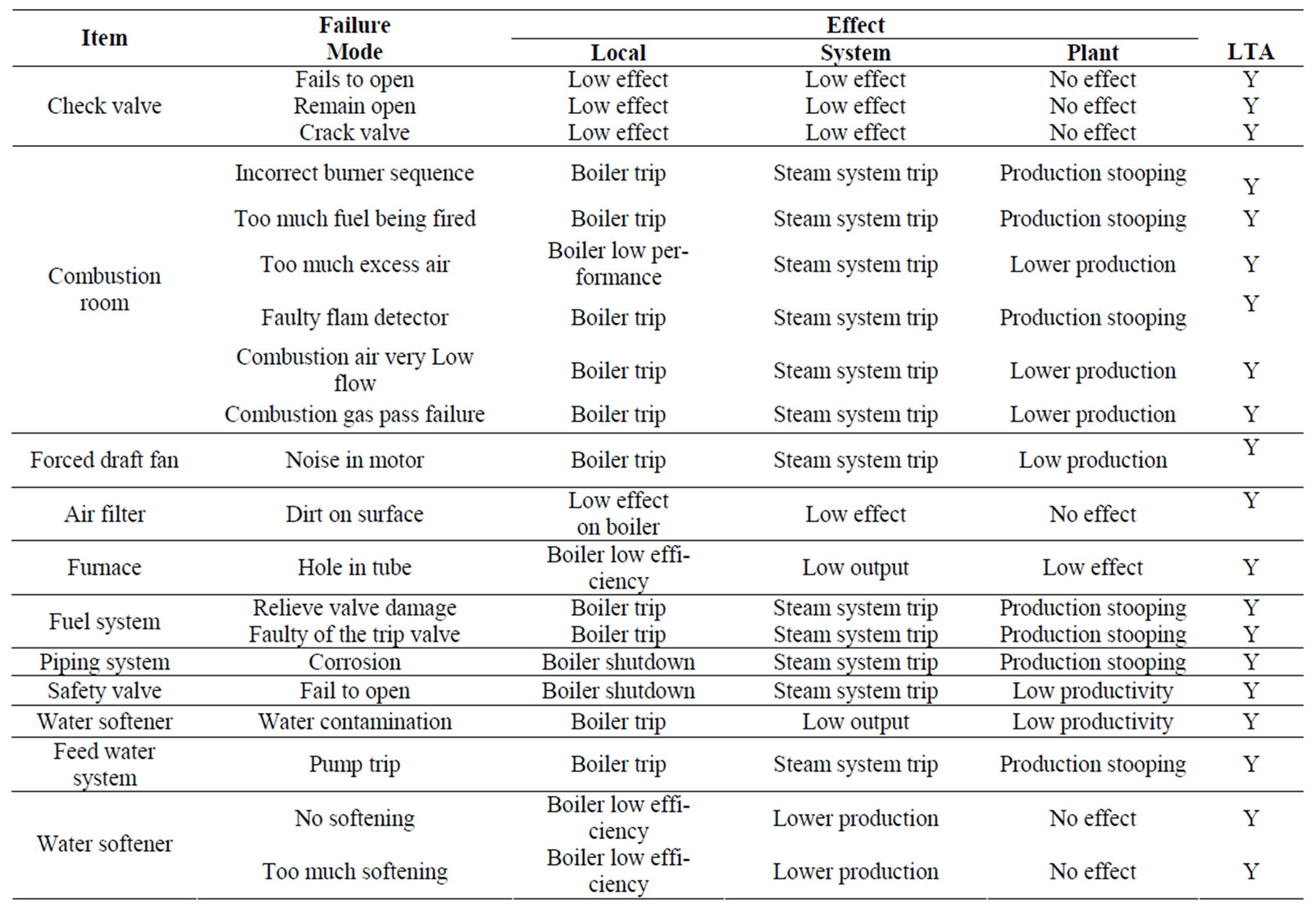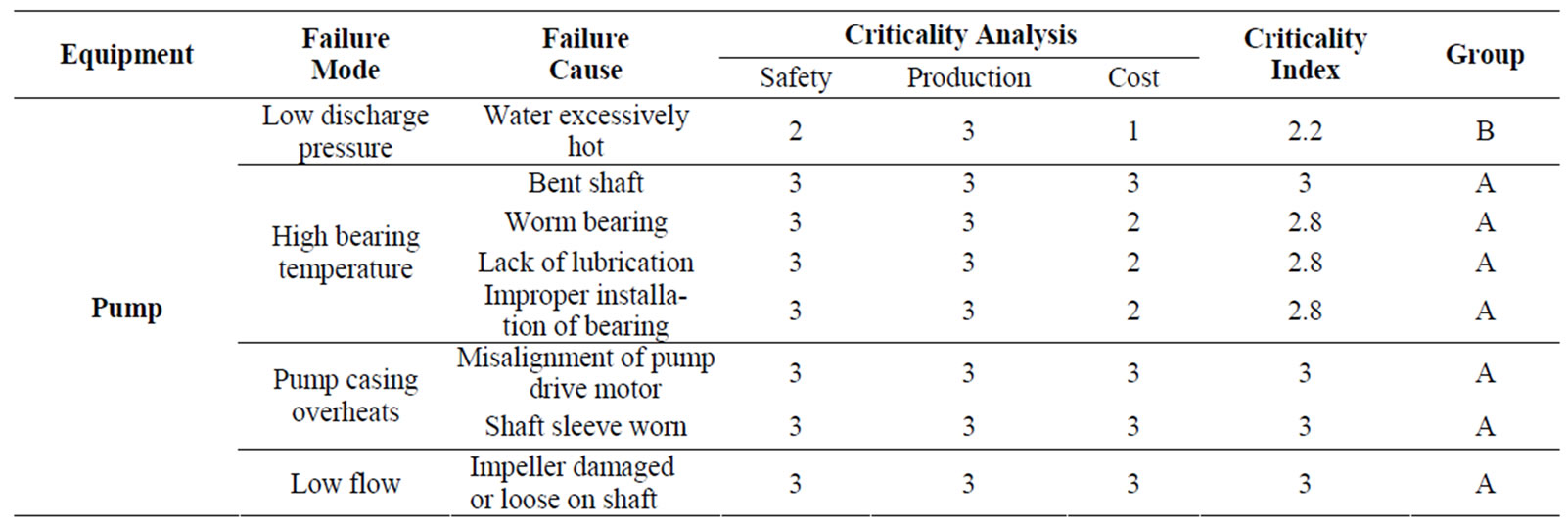Engineering
Vol. 2 No. 11 (2010) , Article ID: 3165 , 4 pages DOI:10.4236/eng.2010.211109
Reliability-Centered Maintenance Methodology and Application: A Case Study
Industrial Engineering Department, Faculty of Engineering, Fayoum University, Al Fayyum, Egypt
E-mail: Islamhelaly@yahoo.com
Received September 15, 2010; revised September 27, 2010; accepted October 19, 2010
Keywords: Reliability, RCM, Preventive Maintenance, FMEA, Case Study
ABSTRACT
This paper describes the application of reliability-centered maintenance methodology to the development of maintenance plan for a steam-process plant. The main objective of reliability-centered maintenance is the cost-effective maintenance of the plant components inherent reliability value. The process-steam plant consists of fire-tube boiler, steam distribution, dryer, feed-water pump and process heater. Within this context, a mainte-nance program for the plant is carried out based on this reliability-centered maintenance concept. Applying of the reliability-centered maintenance methodology showed that the main time between failures for the plant equipments and the probability of sudden equipment failures are decreased. The proposed labor program is carried out. The results show that the labor cost decreases from 295200 $/year to 220800 $/year (about 25.8% of the total labor cost) for the proposed preventive maintenance planning. Moreover, the downtime cost of the plant components is investigated. The proposed PM planning results indicate a saving of about 80% of the total downtime cost as compared with that of current maintenance. In addition, the proposed spare parts programs for the plant components are generated. The results show that about 22.17% of the annual spare parts cost are saved when proposed preventive maintenance planning other current mainte-nance once. Based on these results, the application of the predictive maintenance should be applied.
1. Introduction
Steam system is an important part of many processing. Maintenance, availability, reliability and total maintenance reliability cost are some of the most important factors of steam-process plant. The plant provides heat energy to Egyptian Minerals and Salts Company (EMISAL), EL-Fayoum, Egypt. The main product of the company is sodium sulphate unhydrous and sodium chloride.
This work aims to generate a maintenance program that based on the RCM technique for the process-steam plant components. This technique should be able to minimize the downtime (DT) and improve the availability of the plant components. Also, it should benefits to decrease the spare parts consumption system components.
RCM is a systematic approach to determine the maintenance requirements of plant and equipment in its operating [1]. It is used to optimize preventive maintenance (PM) strategies. The developed PM programs minimize equipment failures and provide industrial plants with effective equipment [2]. RCM is one of the best known and most used devices to preserve the operational efficiency of the steam system. RCM operates by balancing the high corrective maintenance costs with the cost of programmed (preventive or predictive) polices, taking into account the potential shortening of “useful life” of the item considered. But it is difficult to select suitable maintenance strategy for each piece of equipment and each failure mode, for the great quantity of equipment and uncertain factors of maintenance strategy decision [3,4].
RCM philosophy employs preventive maintenance, predictive maintenance (PdM), real-time monit-oring (RTM), run-to-failure (RTF) and proactive maintenance techniques is an integrated manner to increase the probability that a machine or component will function in the required manner over its design life cycle with a minimum of maintenance [5,6].
2. Reliability-Centered Maintenance Methodology
Reliability-centered maintenance (RCM) is the optimum mix of reactive, time or interval-based, condition-based, and proactive maintenance practices. These principal maintenance strategies, rather than being applied independently, are integrated to take advantage of their respective strengths in order to maximize facility and equipment reliability while minimizing life-cycle costs.
Total productive maintenance (TPM), total maintenance assurance, preventive maintenance, relia-bilitycentered maintenance (RCM), and many other innovative approaches to maintenance problems all aim at enhancing the effectiveness of machines to ultimately improve productivity [7].
2.1. Reliability-Centered Maintenance Components
The components of RCM program are shown in Figure 1. This figure showing that RCM program consists of (reactive maintenance, preventive maintenance, condition based maintenance, and proactive maintenance) and its patterns.
As shown in Figure 2, the RCM steps are presented. The steps describe the systematic approach used to implement the preserves the system function, identifies failure mode, priorities failure used to implement the preserves the system function, identifies failure mode, priorities failure modes and performs PM tasks. The RCM steps are as follows [8]:
• Step1: system selection and data collection.
• Step2: system boundary definition.
• Step3: system description and functional block.
• Step4: system function functional failures.
• Step5 : failure mode effect analysis
• Step6: logic tree diagram.
• Step7: task selection.
2.2. System Selection and Data Collection
Determining the list of the system components is one of the first steps in RCM. The criticality analysis requires different kind of data of each component that build up the system. The effect of failure of the system main components may effect system productivity and maintenance cost. The factors effecting selection of critical system are as follows:
1) Mean-time between failures (MTBF).
2) Total maintenance cost.
3) Mean time to repair (MTTR).
4) Availability.
2.3. Logic Tree Analysis (LTA)
The basic (LTA) uses the decision tree structure shown in Figure 3. From this figure, decision bins: 1) safetyrelated, 2) outage-related, or 3) economic-related were noticed. Each failure mode is entered into the top box of the tree, where the first question is posed: Does the operator, in the normal course of his or her duties, know that something of an abnormal or detrimental nature has occurred in the plant? It is not necessary that the operator know exactly what is awry for the answer to be yes [6].
2.4. Criticality Analysis
Criticality analysis is a tool used to evaluate how equipment failures impact organizational performance in order to systematically rank plant assets for the purpose of work prioritization, material classification, PM/PdM development and reliability improvement initiatives [9]. In general, failure modes, effects and criticality analysis (FMEA/FMECA) requires the identification of the following basic information in Table 1. In Figure 4, algorithm for the calculation of equipments criticality is presented. This figure shows the calculation steps of the equipments criticality.
The criticality is assessed based on the effect of er-

Figure 1. Components of RCM program.

Figure 2. Main steps of the RCM.
rors/faults and on the time from the occurrence until the effect occurs on the installation and is quantified with 1, 2, 3 in Table 1.
EC = (30*P + 30*S +25*A+15*V)/3 (1)
where,
EC: is the equipment criticality, %
P: is the product
S: is the safety
A: is the equipment stand by
V: is the capital cost.
3. Case Study
We select the most critical system in the sodium chloride plant which contains the most critical items. The plant provides heat energy to perform the drying process for the sodium chloride anhydrous lead to the aimed degree.
3.1. System Description
The structure of the steam-process plant is presented in

Figure 3. Reliability-centered maintenance (RCM) logic tree.

Table 1. Criticality analysis.
Figure 5. The steam-process plant consists of a fire-tube boiler, feed-water pump, condensate tank, dryers and heat exchanger (PH).
Fire-tube boiler components are shown in Figure 6. A fire-tube boiler is a type of boilers in which hot gases from the fire pass through one or more tubes within the boiler. It is one of the two major types of boilers, the other being the water tube boiler. A fire tube boiler can be either horizontal or vertical. A fire-tube boiler is sometimes called a “smoke-tube” or “shell boiler” boiler.
3.2. System Boundary Definition
Some gross system definition and boundaries have been established in the normal course of the plant or facility design, and these system definitions have already been used as the basis of system selection. These same definitions serve quite well to initially define the precise boundaries that must be identified for the RCM analysis process [9].

Figure 4. Algorithm for the calculation of equipments criticality.

Figure 5. The structure of steam-process plant.


Figure 6. Fire-tube boiler.
3.2.1. Boundary Overview (see Table 2)

Table 2. Boundary overview.
3.3. Information Collection
Uniformity, by researching some of the necessary system documents and information that will be needed in subsequent steps, the absence of documentation and data records was a huge problem that makes the system analysis process more difficult. Thus, a greater effort must be done to collect the missing data.
1) Some cards that contain few maintenance actions that have been under taken to some equipments.
2) Some of the operating and maintenance manuals for a few number of equipment.
All of the other information has been collected through a walk down through EMISAL faculties, and personal meeting with EMISAL staff. Fortunately, in most situations, there are plant personnel on site who have essential elements of this data stored either in their desks or their minds. Also Original Equipment Manufacturer (OEM) recommendation stands ready to supply some information.
3.4. Functional Block Diagram
The Functional block diagram for the process is introduced in Figure 7. This figure shows the input resource and output for the system main components.
3.5. System Root Cause Failure Analysis (RCFA)
As shown in Tables 3 and 4, root cause failure analysis for critical equipments in steam system (fire tube boiler and feeding pump) is presented. The cause analysis (failure mode, reason and root cause) for the most critical equipments in the steam system which is [9]:
1) Fire tube boiler.
2) Multi-stage centrifugal pump.
3.6. Failure Mode and Effect Analysis (FMEA)
Failure mode and effect analysis is a tool that examines potential product or process failures, evaluates risk priorities, and helps determine remedial actions to avoid identified problems. The spreadsheet format allows easy review of the analysis. Failure mode and effect analysis help on identifying and the creation of functional failure.
At the following tables (Tables 5 and 6) we will represent the failure Mode and effect analysis for the same two equipments we represent its root cause failure analysis [9]:
1) Fire-tube boiler.
2) Multi-stage centrifugal pump.
3.7. Criticality Analysis for Plant Components
Then the safety related effects take weight of 40%, Production related effects 40%, and the cost related effects 20%. The failure mode categories A, B, C, and D depending on the criticality index are as shown in Table 7. Tables 8 and 9 show the criticality analysis for boiler, pump, respectively.
3.8. Task Selection
A great strength of RCM is the way it provides simple, precise and easily understood criteria for deciding which

Figure 7. The functional block diagram.

Table 3. Boiler Root Cause Failure Analysis.

Table 4. Pump root cause failure analysis.

Table 5. Boiler failure mode effect analysis.

Table 6. Pump failure mode effect analysis.

Table 7. Criticality group.

Table 8. Criticality analysis for boiler.

Table 9. Criticality analysis for the pump.
(if any) of the proactive tasks is technically feasible in any context, and if so for deciding how often they should be done and who should do them.
Whether or not a proactive task is technically feasible is governed by the technical characteristics of the task and of the failure which it is meant to prevent. Whether it is worth doing is governed by how well it deals with the consequences of the failure. If a proactive task cannot be found which is both technically feasible and worth doing, then suitable default action must be taken. Maintenance tasks are consisting of run-to-failure (RTF), time-directed maintenance, condition-directed maintenance (CD) and failure-finding (FF). The maintenance task for the boiler is illustrated in Table 10.
3.9. Maintenance Labor Force
The maintenance labor force is presented in Table 11. This table shows the size of maintenance labor force calculations for the PM levels (six monthly, monthly and weekly). In addition, the labor saving cost is introduced in Table 12. Not that the proposed labor cost (295200 $/year) decreased with respect to the current values (220800 $/year).

Table 10. Maintenance task.

Table 11. The size of maintenance labor force.

Table 12. Labor saving cost.
Downtime Cost
• Average CM downtime of the feed water pump = 20 hr/year.
• Average CM downtime of the fire tube boiler = 30 hr/year.
• Average CM downtime of the system auxiliaries = 10 hr/year.
• Average down cost rate = 10000 $/hr
• Total downtime cost rate = 600,000 $/year
• Proposed saving downtime cost = 480,000 $/year
Spare Parts Program
The proposed spare parts program is shown in Table 13. This table shows that the spare parts for the plant main components (feed-water pump, water tube boiler ant steam turbine). Proposed spare parts program results indicate a saving of about 22.17% of the spare parts total cost as compared with that of the current maintenance (CM).
4. Conclusions
The results of the RCM technique applied of the plant show that the PM proposed tasks and planning are generated. Moreover, PM is consisted of on-condition and scheduled maintenance. The RCM had great impact on the PM tasks. The Run-To-Failure (RTF) frequency has been decreased. It is recommended to perform these tasks (CD, TD and FF) every yearly, six monthly and monthly.

Table 13. Proposed spare parts program (yearly).
The proposed labor program is carried out. The results show that the labor cost decreases from 295200 $/year to 220800 $/year (about 25.2% of the total labor cost) for the proposed PM planning. Moreover, the downtime cost (DTC) of the co-generation plant components is investigated. The proposed PM planning results indicate a saving of about 80% of the total downtime cost as compared with that of current maintenance (RTF). The system reliability increase with decreasing the labor cost.
The proposed spare parts program for the co-generation plant components (feed water pump, boiler and turbo-generator) are generated. The results show that about 22.17% of the annual spare parts cost are saved when proposed PM planning other current maintenance (RTF) once.
5. Acknowledgements
The author wishes to express his thanks to the staff members of the Egyptian Salts & Minerals Company (Emisal), El-Fayom, Egypt, for their support during carrying out this work.
6. REFERENCES
- M. Dixey, “Putting Reliability at the Center of Maintenance,” Professional Engineering, Vol. 6, No. 6, June 1993, pp. 23-25.
- S. A. Abdulrohim, O. D. Salih and A. Raouf, “RCM Concepts and Application: A Case Study,” International Journal of Industrial Engineering, Vol. 7, No. 2, 2000, pp. 123-132.
- J. Wang and J. Chu, “Selection of Optimum Maintenance Strategies Based on a Fuzzy Analytic Hierarchy Process,” International Journal of Production Economics, Vol. 107, No. 1, 2007, pp. 151-163.
- R. K. Sharma, D. Kumar and P. Kumar, “FLM to Select Suitable Maintenance Strategy in Process Industries Using MISO Model,” Journal of Quality in Maintenance Engineering, Vol. 11, No. 4, 2005, pp. 359-374.
- The National Aeronautics and Space Administration, “Reliability-Centered Maintenance Guide for Facilities and Collateral Equipment,” NASA, Washington D.C., February 2000.
- A. M. Smith, “Reliability-Centered Maintenance,” McGraw-Hill, New York, 1993.
- J. Shayeri, “Development of Computer-Aided Maintenance Resources Planning (CAMRP): A Case of Multiple CNC Machining Centers,” Robotics and Computer-Integrated Manufacturing, Vol. 23, No. 6, 2007, pp. 614-623.
- M. Rausand, “Reliability-Centered Maintenance,” Reliability Engineering and System Safety, Vol. 60, No. 2, 1998, pp. 121-132.
- A. H. Gomaa, “Maintenance Planning and Management,” A Literature Study, American University in Cairo, Cairo, 2003.

